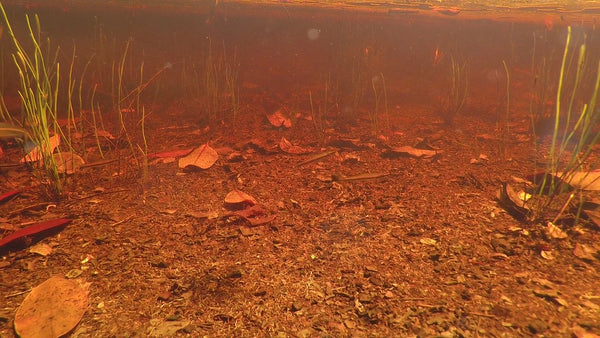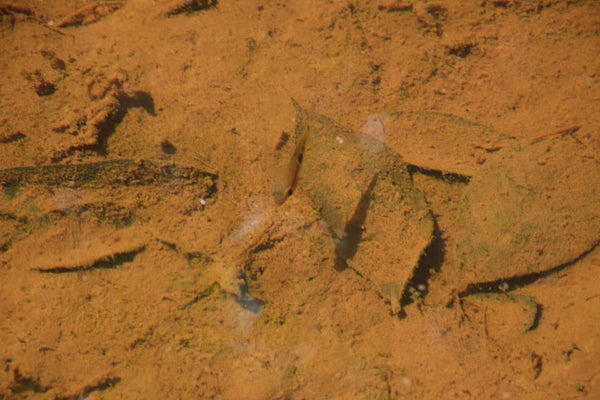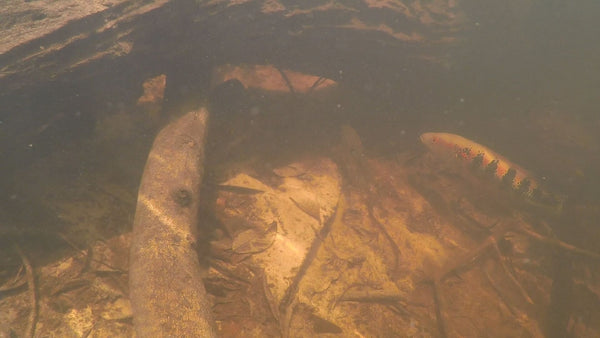- Continue Shopping
- Your Cart is Empty
Downstream thinking...
I realize, I spend an obscene amount of time talking about lots of exotic aquatic habitats- particularly seasonally-inundated forest floors and the like. However, when you think about all of the inspiring types of aquatic habitats or ecological niches that we have to model our aquariums after, it's interesting that we seldom talk about one of the most obvious ones...Streams!
The definition of a "stream" is: "...a body of water flowing in a channel or watercourse, as a river, rivulet, or brook..."
And of course, these little bodies of water flow through jungled areas, where they're bound to pick up some leaves, twigs, and other plant parts as they wind along their path. Leaves, the "jumping off point" of our botanical obsession, form a very important part of these stream habitats.

It is known by science that the leaf litter and the community of aquatic animals that it hosts is, according to one study, "... of great importance in assimilating energy from forest primary production into the blackwater aquatic system."
"Shit, here Fellman goes again..."
Leaf accumulations also function as a means to preserve the nutrients that would be lost to the forests which would inevitably occur if all the material which fell into the streams was simply washed downstream. That's a hugely important ecological role, isn't it?
The fishes, crustaceans, and insects that live in the leaf litter and feed on the fungi, detritus, and decomposing leaves themselves found in streams are very important to the overall habitat.

Now, streams are not only fascinating from an ecological perspective- they are interesting when you explore their composition, formation, and what influences their function and gradual evolution over time.
Hint... a big part of it is the substrate...Yeah, like, what's on the bottom...And how does that influence the overall ecology of the stream.
And how do we work with this stuff in our tanks?
Well...Again...back to the bottom for just a bit.
One of the things that I always find a bit interesting in our aquascaping is that many of us just sort of seem to apply little thought to the substrate of our aquariums. I mean, if you're a planted aquarium geek, you'll spend a huge amount of time creating an "active" bottom, composed of varying fertilizers, aquatic sands, etc.
However, the majority of us tend to simply find a substrate that looks cool to us, wash it, throw it on the bottom, smooth it out somewhat, and move on to the other aspects of aquascaping...
Done.
Oh, sure, a few competition 'scapers will play with the contours a bit as they arrange rock (I'm thinking about the Iwagumi gurus here); however, this is more a of a "design" aspect than an attempt to replicate the bottom of a stream or other body of water as it appears in Nature.
it seems that very little attention is paid by the majority of hobbyists to the bottom of streams and rivers as they appears in Nature, and how the substrate "works" with the entire environment.
I admit, I've been kind of guilty of this, and it's only been recently that I really gave more than a passing thought to what goes on "down there" in nature, especially in streams and rivers. It's a lot more interesting, when you examine the subject more closely- especially from the perspective of how these structures came to be, and what implications they have for fish populations...cool stuff.

Now, sure, you know of my obsession with varying substrate compositions and enhancement of the substrate...You've likely seen my recent work with with different materials, like leaves, botanicals, clays, and sediments that I've shared with you here and elsewhere. It's an idea that I just can't get away from!

However, the physical composition of the substrate materials is but one aspect of these interesting aquatic systems...
Stream and river bottom composition is affected by things like regional weather, current, geology, the surrounding dry lands, and a host of other factors- all of which could make planning your next aquarium even more interesting if you take them into consideration!
If we focus on streams, it's important to note that the volume of water entering the stream, and the depth of the channels it carves out, helps in part determine the amount and size of sediment particles that can be carried along, and thus comprise the substrate.

And of course, the composition of bottom materials and the depth of the channel are always changing in response to the flow in a given stream, affecting the composition and ecology in many ways.
Some leaf litter beds form in what stream ecologists call "meanders", which are stream structures that form when moving water in a stream erodes the outer banks and widens its "valley", and the inner part of the river has less energy and deposits silt- or in our instance, leaves.

There is a whole, fascinating science to river and stream structure, and with so many implications for understanding how these structures and mechanisms affect fish population, occurrence, behavior, and ecology, it's well worth studying for aquarium interpretation! Did you get that part where I mentioned that the lower-energy parts of the water courses tend to accumulate leaves and sediments and stuff?
Likely you did!

Permanent streams will often have different volume and material composition (usually finely-packed sands and gravels, with lots of smooth stones) than more intermittent streams, which are the result of inundation caused by rain, etc.

So-called "ephemeral" streams, typically occur only immediately after rain events (which means they usually don't have fish in them unless they are washed into them from more permanent watercourses). The latter two stream types are typically more affected by leaves, botanical debris, branches, and other materials.

In the Amazon region (you knew I was sort of headed back that way, right?), it sort of works both ways, with the rivers influencing the surrounding land...and then the land "giving" some of the materials back to the rivers...the extensive lowland areas bordering the river and its tributaries, known as varzeas (“floodplains”), are subject to annual flooding, which helps foster enrichment of the aquatic environment.
Although many streams derive their food base from leaves and organic matter, there is a lot of other material present that contributes to its structure. Think along those lines when scheming your next aquarium. Ask yourself what factors would contribute to the bottom composition of the area you're taking inspiration from.

You'll see a variety of bottom compositions in Amazonian and other streams, ranging from the aforementioned leaves and detritus in stream margins, to sand and silt over "cobbles", to boulders covered in algae, to fine patch gravels, and even just silt.

You might even say that rivers and streams act like nature's "sediment sorting machines", as they move debris, geologic materials, and botanicals along their courses. And along the way, varying ecological communities are assembled, with all sorts of different fishes being attracted to different niches.

Interestingly, in streams, the primary producers of the food webs that attract our fishes are algae and diatoms, which are typically found on rocks and wood wherever light and nutrients create optimum conditions for their growth. Organic material that enters streams via leaf fall is acted upon by small organisms, which help break it down.
It is probably no surprise, then, that bacteria (especially in biofilms!) and fungi are the initial consumers of the organic materials that accumulate on the bottom. Like, the stuff many of us loathe. These, in turn, are extremely vital to fishes as a food source. Hence, one of the things I love so much about utilizing a leaf litter bed as a big part of your substrate composition in an aquarium!

Streams which flow over stony, open bottoms, free from natural obstacles like tree trunks and such, tend to develop a rich algal turf on their surfaces.

While not something a lot of hobbyists like to see in their tanks (with the exception of Mbuna guys and true weirdos like me), algae-covered stones and rocks are entirely natural and appropriate for the bottom of many aquariums! (enter a tank with THAT in the next international "natural" aquascaping contest and watch the ensuing judge "freak-out" it causes! )
Grazing fishes, of course, will feed on and among these algal films, and would be logical choices for a stony-bottom-themed aquarium. When we think about the way natural fish communities are assembled in rivers and streams, it's almost always as a result of adaptations to the physical environment and food sources.

Now, not everyone wants to have algae-covered stones or a mass of decomposing leaves on the bottom of their aquarium. However, I think that considering the role that these materials play in the composition of streams and the lives of the fishes which inhabit them is important, and entirely consistent with our goal of creating the most natural, effective aquariums for the animals which we keep.
As a hobbyist, you can employ elements of these natural systems in a variety of aquariums, using any number of readily-available materials to do the job.

Look at the way rocks, soil and branches come together in streams to form interesting physical spaces that fishes utilize for protection, foraging, and reproduction.

By replicating the complex look and physical attributes of these features, including rich substrate, roots of various thickness, and leaves, we offer our fishes all sorts of potential microhabitats. In the aquarium, we tend to focus on the "macro" level- creating a nice wood stack, perhaps incorporating some rock- but we seldom allow the whole picture to come together in a more "natural" way.

This was what inspired me in my last few blackwater aquariums.
The interaction between the terrestrial elements and the aquatic ones. Allowing terrestrial leaves to accumulate naturally among the "tree root structure" we have created fosters this more natural-functioning environment. As these leaves begin to soften and ultimately break down, they will foster microbial growth, biofilms, and fungal growths- all of which will provide supplemental foods for the resident fishes...just like what happens in Nature.

Facilitating these processes- allowing the materials to accumulate naturally and break down "in situ" is a key component of replicating and supporting these microhabitats in our aquariums. The typical aquarium hardscape- artistic and beautiful as it might be, generally replicates the most superficial aesthetic aspects of such habitats, and tends to overlook their function- and the reasons why such habitats form.
When you contemplate the form, function, and the evolution which occurs in streams, you can really push yourself to try some new things in the aquarium!

There is obviously much more to streams than the sands, branches, and leaves which accumualte in them. However, it's important to consider all of these aspects if we really want to understand these habitats from a different perspective.
We have literally an entire planet of amazing habitats from which to draw inspiration, which, in my opinion, is far more interesting and inspiring than last month's "Tank of The Month." Then again, I'm a guy whose idea of a cool aquascape involves brown water, decaying leaves, biofilms, and piles of seed pods...so what the Hell do I know...
Until next time...I hope that you look deeper...and enjoy the research. If you're hungry for a little inspiration- look to Nature. She won't disappoint.
Stay curious. Stay inspired. Stay excited. Stay creative. Stay adventurous...
And Stay Wet.
Scott Fellman
Tannin Aquatics








Scott Fellman
Author